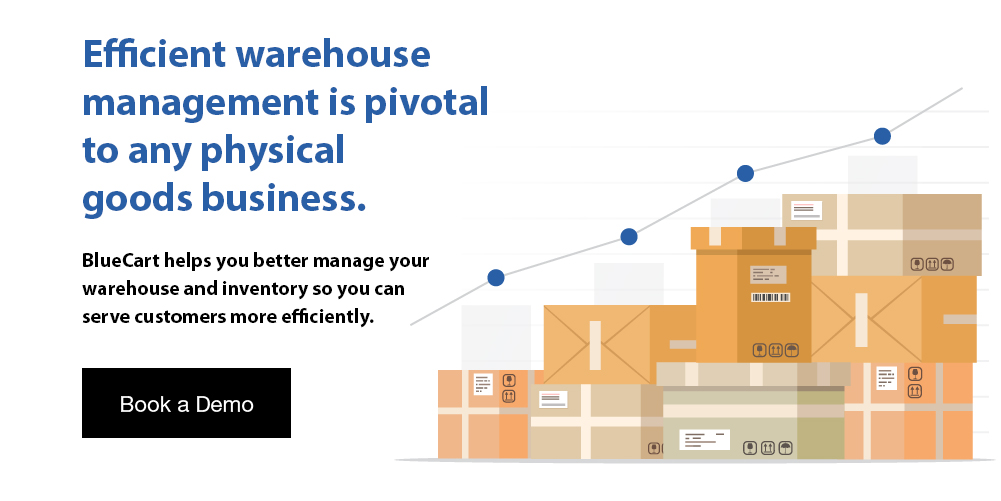Starting a warehouse distribution business is profitable, especially with the rise of online D2C eCommerce vendors and retailers and direct to consumer trends. For businesses that sell online high demand products, having a place to store products before shipping to consumers is crucial to the success of their operations.
Additionally, businesses that sell physical products or receive goods from a wholesale marketplace will need a warehouse to temporarily store their products. Warehousing is a critical process in supply chain management.

Key Takeaway - An eCommerce marketplace online needs physical storage space for all the stock-keeping units (SKU number) in their online inventory. You can capitalize on this need to store eCommerce products and start your own warehousing business. Consider white label vs. private label products.
There are various distribution warehouse business ideas to venture into. However, you need to begin with one, a warehouse, and two, a distribution business plan.
The warehousing industry is huge, and starting a warehouse distribution business can get confusing if you don’t have the right guidelines. Let’s discuss the distribution warehouse business to get you started.

What Is a Distribution Warehouse?
A distribution warehouse is an integral part of the supply chain. It describes the place a product is stored after it is received from manufacturers until it gets delivered to the retailer or customer.
There are different types of warehousing options designed for different purposes and for a range of business sizes. A distribution warehouse is a warehousing model designed to store goods close to the end of the supply chain.
To put it clearly, a distribution warehouse stores products that are ready to be delivered to retailers and customers. Distribution warehouses are designed for quick inbound and outbound product flows.
Besides streamlining its warehouse management process flow, a distribution warehouse makes use of its warehouse organization and storage system, which facilitates tracking, inventory tracking, and locating products within the warehouse.
Key Takeaway - A good distribution warehouse will incorporate a robust warehouse management system (WMS) to track warehouse inventory. The WMS must also be able to manage eCommerce packaging of goods, creating packing slip templates, customize warehouse labels, and product shipping and handling.
Consider using a business process flow chart template to map out your processes. Now that you know what a distribution warehouse is, let’s discuss the intricacies of starting a warehouse distribution business.
How to Start a Warehouse Distribution Business: 7 Tips
Every new business begins with a business plan as part of its efficient business systems. Before you start a warehouse distribution business, it is important to have a solid plan that includes market research, SWOT analysis, an eCommerce marketing plan, and financial projections.
Besides having a business plan, it is important to position your business in a way that wholesale distributors and retailers can trust you. Starting a warehouse distribution business implies that you’ll be entrusted with safely storing and securing a lot of products.
You must be able to offer the right warehousing solutions for your customers. Additionally, you’ll also need to decide on the best warehouse management tools to use for your warehousing operations.
Looking to optimize your warehouse operations for the best efficiency and profitability? Download our free Warehouse Management eBook to get on the right track.
Let’s look into some of the key steps to take when starting a warehouse distribution business.
1. Write Your Business Plan and Conduct Market Research
The need for writing an eCommerce business plan and conducting market research before starting your business cannot be overstated. Starting a warehouse distribution business costs a lot of money, hence it is important to have a plan before you get started.
Researching your niche market will also help you prepare your unique selling point (USP). In addition, it will make it easier to decide if you want to offer additional supply chain solutions based on your target audience's needs.
Here’s a list of what to include in your warehouse and distribution business plan:
- Executive summary
- Company overview
- Industry analysis
- Market analysis
- Competitive analysis
- Marketing plan
- Operations plan
- Financial analysis

2. Specify Your Market
There are millions of products that are stored in warehouses daily. Specifying the type of products or industry you want to venture into will help you prepare your facility to meet up with the storage requirements of such products.
For instance, if your market is clients in the restaurant industry, you will be dealing with a lot of food products. It is crucial to keep your warehouse facility at a certain storage temperature to keep the products fresh.
Your customers may need help shipping frozen food or shipping frozen meat. Specifying your market will position your business to fulfill these needs.
Additionally, specifying your market will help you decide on many components of your business. These components include the size of the warehouse, storage equipment, utility costs, and the inventory management techniques to adopt.
3. Get Your Licenses
Like every other business, it is essential that you take care of your legal paperwork. Covering all your legal bases will save you a lot of stress in the long run. Do it early!
You need to complete the paperwork and forms required by your city or state to guarantee that the legal aspects of starting a warehouse distribution business are taken care of. Here are some typical wholesale licenses you should get for your warehouse and distribution business:
- Employee identification number (EIN)
- Doing business as (DBA) registration
- Tax identification number (TIN)
- Tax permits based on your city or state
4. Purchase Necessary Equipment
Investing in high-performance warehousing equipment is key to the success of your distribution warehouse business. The right storage equipment will be the reason your customers keep using your facilities.
You should have the following equipment in your warehouse:
- Various storage options, such as carousels, racks, cabinets and shelving, and liquor storage
- Lifting equipment such as pallet jacks, forklifts, and service carts
- Conveyors such as belt conveyors and gravity roller conveyors
- Labeling options such as shipping label printer
5. Employ the Right People
The success of your warehouse business depends on the people who comprise your team. With the right eCommerce team structure, you can boost warehouse business efficiency and improve customer satisfaction.
Additionally, some warehouse equipment will require manual operation. So, it is important to employ skilled labor. Choosing the finest team is vital because employees will play a crucial role in your warehouse operations.
Here are some vital positions to hire as you start your warehouse operation:
- Inventory control manager
- Order management specialist
- Material handler
- Warehousemen
- Warehouse manager
- Shipping specialist
- Demand planning manager
- Distribution center manager
- Machine operator
6. Integrate Warehouse Management Systems
A warehouse management system is perfect for 3PL companies and businesses that offer warehousing services. Many of the problems that every warehousing and distribution company has on a daily basis can be solved with the help of a WMS and top ERP systems.
Warehouse management solutions quickly and effectively evaluate warehouse data, pinpoint inventory shortfalls, and highlight urgent inventory needs. With the aim of enhancing your warehouse organization and productivity, this enables you to view crucial figures at a moment's notice. These systems should also help you calculate inventory turnover.
7. Market Your Warehouse
Marketing is a foundational part of starting a business. The warehousing industry uses the B2B business model and your target audience is mostly eCommerce businesses across various niche markets.
Implementing eCommerce marketing strategies that will reach your unique clientele is important. You can integrate eCommerce marketing automation tools into your business operations.
It may be a bit challenging at first, but implementing a clearly structured marketing strategy will help you get results. Besides digital and online marketing, you can also list your warehouse on a wholesale directory. This will help you get the attention of wholesalers that may require a warehouse to store their products.
Potential Profit Ideas for a Warehouse Business
There are multiple ways to increase revenue if you own a warehouse business. Allow us to share some of the ways warehouse businesses can increase their profits and revenue.
- Convert warehouse space to office space. If the location of your warehouse business is convenient, it might bring more revenue if you rent it out as an office space. You don’t have to fully commit to that. Instead, only convert part of the warehouse to office space.
- Offer parking spots. Part of the warehouse can be converted into a parking space. They can be rented for a good monthly fee.
- Lease warehouse space. Naturally, that is the most common way for warehousing businesses to earn profits.
- Organize events. The high ceiling heights of warehouses make them a great place to organize various events. If you have a large enough space that can gather a lot of visitors, you can rent out the warehouse to event planners or other businesses. Examples of events that can be organized in a warehouse include photoshoots, music events, and art sessions.
- Start a farmer’s market or flea market. A growing number of consumers search for organic and locally-grown food products. That’s why farmer’s markets have increased in popularity. The sustainability trend has made flea markets more popular as well. A warehousing business can benefit from hosting such events biweekly.
- Start a paintball or laser tag business. Warehouses are an ideal setting for a paintball or another type of shooting sport. The interior can be created fairly cheaply.
- Launch an indoor climbing center. The height of warehouse buildings allows to turn them into climbing centers easily. Make sure you invest in state-of-the-art equipment as safety is of the utmost importance in this type of facility.

Frequently Asked Questions About Starting a Warehouse Distribution Business
From writing your warehouse and distribution business plan to getting your facility ready for potential customers, a lot goes into running a distribution warehouse business. Let’s answer some common questions about starting a warehouse business.
How Do I Get Clients For My Warehouse?
Getting B2B clients for your warehouse business can be difficult if you do not have the right marketing plan in place. As with other eCommerce B2B businesses, you need to offer a value proposition and a USP before your target clients will see you as the market leader.
Here are some marketing ideas to get clients for your warehousing business:
- Make a company website
- Use eCommerce search engine optimization
- Leverage eCommerce email marketing
- Social media marketing
- Create content friendly to eCommerce search engines
- Incentivize customer referrals
- Newspaper ads
- Print media
- Networking events
- Street signage
Which Product Is Best for Distribution?
There are numerous distribution warehouse business ideas and products to distribute. Here are some of the best products for distribution:
- Wholesale produce
- Pet food
- Wine and alcohol
- Bakery products
- Wholesale dairy products
How Much Does It Cost to Set Up a Warehouse?
Setting up a warehouse can be quite expensive. A 30x40’ - warehouse structure will cost about $25,000, while a 50,000- to 60,000-square-foot distribution center may cost between $750,000 and $1,000,000, depending on the amenities and building materials.
Storing Up for Later
Starting a warehouse distribution business is quite lucrative. Besides the amount of money that goes into setting it up, there is a lot to gain from the business.
However, it is crucial to use a warehouse management system to automate your business processes. Investing in the right equipment and skilled labor is also key to running a successful business.